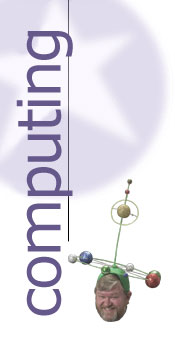CHKDSK, a Command That's Misunderstood
by Lloyd Borrett
Today's Computers, Wizard's Notebook, November 1985
 |
Wizard's Notebook. |
One of the most misunderstood DOS commands is CHKDSK. At
first it may seem trivial. After all its primary purpose is
simply to determine the amount of space remaining on a given
disk. There are, however, several other uses for the CHKDSK
command.
Unfortunately, for one to fully understand CHKDSK one
must also have knowledge of the internal structure of the
DOS directory system. That would take many pages of
explanation so instead let us concentrate on the essentials.
A quick reading of the IBM DOS manual may lead you to
believe that CHKDSK is used to report the status of the
directory and File Allocation Table for the specified disk.
In fact CHKDSK does more than report the status of the
directory and FAT, it modifies them if it finds an error.
For example, if CHKDSK discovers a FAT entry containing a
number that is too large to represent a physical sector, it
will set that allocation block back to its free state, so
that it can again be used to store a legitimate file.
Another of CHKDSK's interesting efforts is directed
toward the freeing of disk allocation units that are marked
"in use" by the FAT but do not belong to any file. Such a
situation often arises if an application program fails to
obey the laws of DOS.
When applied to a normal disk, CHKDSK returns a report
that looks like this:
Volume MAIN DISK created Aug 16, 1985 6:57p
21225472 bytes total disk space
32768 bytes in 3 hidden files
147456 bytes in 18 directories
6348800 bytes in 400 user files
14671872 bytes available on disk
655360 bytes total memory
321376 bytes free
CHKDSK may also return a report that states 24576 bytes
in bad sectors if it discovers that certain sectors have
been marked as damaged.
The command may also return one or more error messages,
each of which indicates the existence of an abnormal
condition. The more important CHKDSK messages include:
- Allocation error for file filename.
Indicates that an invalid allocation unit number was
discovered in the FAT. CHKDSK "de-allocates" the
offending allocation unit and truncates the file at the
end of the previous allocation unit. If the file
contains a program, then this measure is futile, since
the program has probably been rendered unusable. If, on
the other hand, the file contains data, then some data
may be saved.
- xxxxxxxx bytes disk space freed.
This error message indicates that allo¬cation units
formerly marked as used, but not actually in use, have
been "de-allocated".
- Directory error-file: filename.
Indicates that a directory entry was discovered for a
nonexistent file. In other words, there were no
allocation units assigned to this file. CHKDSK removes
the phantom file from the directory.
- Diskette (or Drive) not initialized.
If CHKDSK can not find the directory or FAT, it assumes
the disk has never been formatted. If this happens with
a disk that you know has been formatted, first try to
DISKCOPY the disk. If that fails, try to COPY all files
to a new disk. In most cases, this attempt will not be
any good at all, but that's okay — you did make a
backup, didn't you?
- File size error for file filename.
This error message is returned when CHKDSK discovers
that the size of a file as indicated by the directory
entry does not agree with the actual size of the file,
which it can calculate by counting allocation units. If
this happens, CHKDSK adjusts the figure contained in the
directory entry.
- Files cross-linked: filename and filename.
When CHKDSK emits this error message it means that it
has discovered two directory entries that describe the
same data block. A situation like this is not likely to
arise, but in any case it is not lethal as far as data
integrity is concerned, so CHKDSK does not take any
action. It leaves it up to you to correct by copying
both files to different file names, then erasing both of
the original directory entries.
In addition to these error messages, there are also the
usual DOS error messages that may crop up from time to time.
All of these are self-explanatory and easy to correct.
It is quite essential that CHKDSK be run on a regular
basis, especially if you are using a fixed disk drive.
Before doing a backup, always run CHKDSK. There is no point
in wasting your time backing up a corrupted disk.
Unfortunately for many, CHKDSK is an essential command that
has been totally overlooked or misunderstood. It's worth
taking the time to become familiar with it.
Lloyd Borrett is support co-ordinator for HiSoft
Computers, president of the Australian PC User
Association, founder and president of the Melbourne PC
User Group and system operator of the PC Connection
bulletin board system.
Local time: 5:35 am Friday 28 November 2025
|


